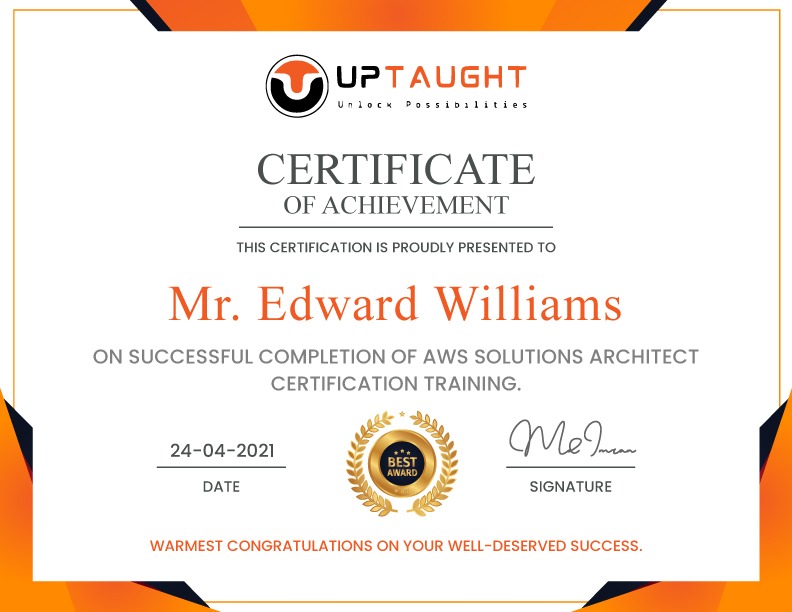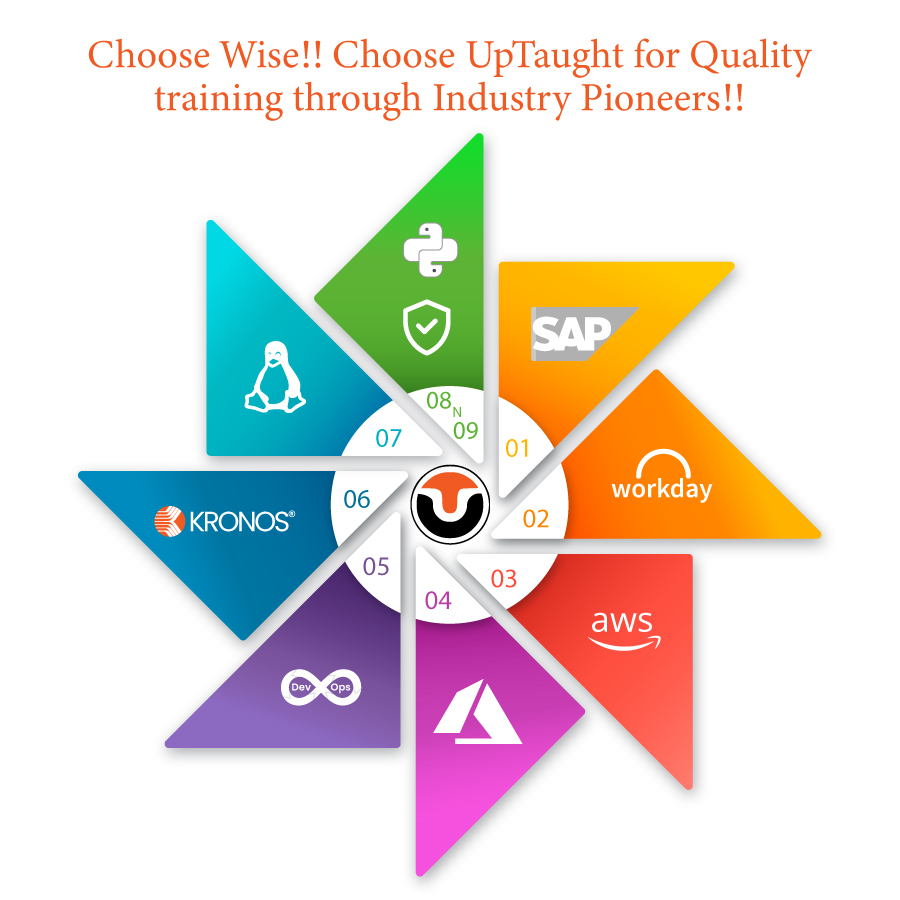AWS Solutions Architect Certification Training
Amazon Web Services, world’s most comprehensive and broadly adopted cloud platform, providing more than 200 featured services from global data centers. AWS Solution Architect training is tailored by industry experts as per the industry demands. This training helps you to identify the appropriate Amazon Web Services based on storage, cost optimization, compute, databases, network, and security requirements. This training helps you understand how to design resilient, high-performing, secure & cost-optimized architectures. On completing this course, you will be confident enough to use the AWS skills tracker to build AWS Cloud Migration skills and to map your progress. This certification training is completely aligned to AWS Certified Solutions Architect Exam with the best course materials designed by the experts with 10+ real-time scenarios.
-
LevelAll Levels
Start Date
Time
Duration
Type
Mode of Training
Course Curriculum
Module 1 – Introduction to AWS
-
1. Cloud Computing
-
2. Cloud deployment and service models
-
3. AWS Global Infrastructure and its benefits
-
4. AWS Regions, Availability Zones, and Edge Locations
-
5. AWS Services
-
6. Ways to access AWS Services: AWS CLI, AWS SDK, AWS Management Console
Module 2 – Security Management in AWS
-
1. User management through Identity Access Management (IAM)
-
2. Various access policies across AWS Services
-
3. AWS Cognito
-
4. AWS Security & Encryption: KMS, CloudHSM, Sheild, and WAF
-
5. API keys service access
-
6. Best practices for IAM
-
7. Access billing and create alerts on billing
Module 3 – Object Storage Options
-
1. S3 bucket
-
2. Storage classes in S3
-
3. Glacier Deep Archive
-
4. Life cycle policy in S3
-
5. S3 Lock Policies
-
6. S3 Performance Optimization
-
7. Cost optimization for S3
-
8. Difference between S3, EBS and EFS
-
9. Glacier: Glacier Vault Policies
-
10. Storage Gateway and its types
Module 4 – Amazon EC2
-
1. Start, stop and terminate an EC2 Instance
-
2. Security Groups
-
3. AMI
-
4. VPC, ENI, Public, and Private IP
-
5. Storage services
-
6. Instance Store
-
7. EBS and its types
-
8. SSDs and Provisioned IOPS
-
9. Hard Disk Drive
-
10. EFS
-
11. EBS vs EFS
-
12. Cost optimization
Module 5 – Load Balancing, Auto-Scaling, and Route 53
-
1. Start, stop and terminate an EC2 Instance
-
2. Security Groups
-
3. AMI
-
4. VPC, ENI, Public, and Private IP
-
5. Storage services
-
6. Instance Store
-
7. EBS and its types
-
8. SSDs and Provisioned IOPS
-
9. Hard Disk Drives
-
10. EFS
-
11. EBS vs EFS
-
12. Cost optimization
Module 6 – Database Services and Analytics
-
1. Amazon RDS and its benefits
-
2. Read Replica
-
3. RDS IAM Authentication
-
4. Aurora: Aurora Serverless & Global Databases
-
5. DynamoDB
-
6. ElastiCache: Working, Redis vs Memcached
-
7. Amazon RedShift: Redshift Spectrum
-
8. Kinesis: AWS Kinesis Data Streams, AWS Kinesis Data Firehouse
-
9. AWS Lake Formation
-
10. AWS Athena
Module 7 – Networking and Monitoring Services
-
1. VPC – Benefits and Components
-
2. CIDR Notations
-
3. Network Access Control List v/s Security Groups
-
4. NAT (Network Address Translation): NAT Devices, NAT Gateway and NAT instance
-
5. VPC peering
-
6. Direct Connect
-
7. Private Link
-
8. Classic Link
-
9. AWS CloudWatch
-
10. AWS CloudTrail
-
11. AWS Config
-
12. Trusted Advisor
Module 8 – Applications Services and AWS Lambda
-
1. VPC – Benefits and Components
-
2. CIDR Notations
-
3. Network Access Control List v/s Security Groups
-
4. NAT (Network Address Translation): NAT Devices, NAT Gateway and NAT instance
-
5. VPC peering
-
6. Direct Connect
-
7. Private Link
-
8. Classic Link
-
9. AWS CloudWatch
-
10. AWS CloudTrail
-
11. AWS Config
-
12. Trusted Advisor
Module 9 – Configuration Management and Automation
-
1. Infrastructure as Code
-
2. CloudFormation and its components
-
3. Templates in CloudFormation
-
4. Stack in CloudFormation
-
5. Resource deletion policies in CloudFormation
-
6. Introduction to AWS OpsWorks
-
7. AWS OpsWorks services
-
8. Components of AWS OpsWorks Stack
-
9. OpsWorks Lifecycle Events and Deployment Commands
-
10. OpsWorks for Chef Automate
-
11. AWS OpsWorks for Puppet Enterprise
-
12. Auto Healing
-
13. Elastic Beanstalk
-
14. Components of Elastic Beanstalk
-
15. Beanstalk v/s OpsWorks v/s CloudFormation
Module 10 – AWS Architectural Designs – I
-
1. AWS Well-Architected Framework
-
2. How to Build a Well-Architected Framework
-
3. Pillars of AWS Well-Architected Framework
-
4. Basics of Resilient Architecture
-
5. Disaster Recovery (DR)
-
6. Options to Implement DR Plans
-
7. Basics of Performant Architecture
Module 11 – AWS Architectural Designs – II (Self-Paced)
-
1. Well-Architected Framework
-
2. Specify Secure Applications and Architectures
-
3. Determine how to secure application tiers
-
4. Determine how to secure data
-
5. Define networking infrastructure for a single VPC application
-
6. Design Cost-Optimized Architectures
-
7. Determine how to design cost-optimized storage
-
8. Determine how to design cost-optimized compute
AWS Solutions Architect Certification Training
-
LevelAll Levels

Instructor Name- Gabriel
Instructor Qualification- Certified in AWS Solutions Architect,AWS TCO and Cloud Economics AWS Business Professional AWS Technical Professional AWS Cloud Practitioner Essentials
Instructor Description:
- Trained AWS Solution Architect Course for almost 1200 students at the same time in an Initiative by the Andhra government (APSSDC) to promote skill development & entrepreneurship in the state of Andhra Pradesh in India
- “AWS Academy Accredited Educator” accreditation from AWS
- Planned, organized, and developed training materials that met specific needs, receiving 4.5 and 5.0 scores on a 5 point scale, from the audience on trainer assessments out of a scoring system 1 to 5
- Strong Theoretical & Practical Knowledge
- Expert level Subject Knowledge and fully up-to-date on real- world industry applications
Roadmap
Salary range
FAQs
It depends on how much experience you already have with AWS. Mostly it takes from 2 to 3 weeks to acquire adequate skills if you are intermediate and if you are a total beginner it takes around 3 to 4 months.
The answer is a resounding ‘yes’ for AWS is the global choice of the majority when it comes to various products of cloud services and it has created its milestone and built its brand intensity making it a sound service platform.
Absolutely not! Coding is not a necessary skill for Solution Architect Associate or practitioner training. Though coding has its own benefits, it is not necessary.
The Cloud Practitioner exam is 100 USD. Associate-level exams are 150 USD. Professional-level and Specialty exams are 300 USD.
The AWS Solutions Architect Associate Certificate is valid for three years.
Yes. The certification will be valid for only three years. After that, you have to apply for recertification.
You will be qualified to retake the exam only after 14 days from your earlier attempt.
Your career will greatly, benefit from the addition of an AWS Solution Architect Certification because:
- Amazon Web Services (SAA-C02) certification is considered as the most esteemed IT Certification globally – Global Knowledge Study.
- In the most recent Magic Quadrant report released by Gartner, AWS retained its position as the king of cloud Infrastructure as a service (IaaS) providers.
- The public cloud market – cloud apps (software-as-a-service); cloud development and data platforms (platform-as-a-service); and cloud infrastructure (infrastructure-as-a-service) – will influence $411 billion by 2022. In 2020, the combined platform and infrastructure markets will develop another 30%, from 2019 to $132.8 billion – Forrester.com
If you fail to ace the AWS Solutions Architect certification exam, you can reappear by paying the complete registration fee.
You have to form an Azure Free Tier account to perform all the hands-on . The stepwise guide for generating a Free Tier account will be accessible in the LMS and UpTaught’s Support Team will assist you 24*7 in case you have any concern.
The following skills are needed for an AWS Solutions Architect:
Programming or scripting languages – Java, Python, or C#; Data storage fundamentals; AWS service selection; Cloud-specific patterns and technologies; Fluency in at least one operating system (Linux, Windows, Solaris, Ubuntu, or UNIX); Communication; Networking
AWS Solutions Architect is an IT professional who is accountable for deploying applications to infrastructure in the AWS cloud.
The main responsibilities of an AWS Solutions Architect:
- Finding a solution to business problems with technology implementation
- Identifying the right platform, programming language, and framework for generating a solution
- Deciding on system maintenance and future scaling
- Finding and minimizing the risks associated with third-party platforms
- Deciding the look and feel of the software
- Ensuring that infrastructure and architecture are well implemented
- Monitor systems routinely to ensure that all business goals are met
- Ensuring sustainability of configuration management
The cost of the AWS Certification Examination is 150USD.
As per research, there is a dearth of experienced AWS in the market. Thus, this is the best time to get certified and start your career in the AWS cloud computing industry.





